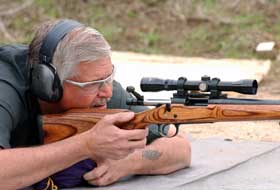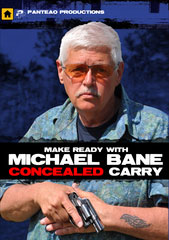What I like about the Hickok book, aside from the fact that Eickoff (read this interview) is a genuinely gifted writer and storyteller, is that he understands that tales like these take place in multiple realities — hell, I'd argue that even reality takes place in multiple realities. A retelling of the history of Wild Bill (or Doc Holliday or Brother Wyatt) really doesn't move us forward in the understanding of the man or the times in which he lived unless we're able to connect the mythic, the subconscious, the spiritual dots.
Eickhoff reflexively understands this. Considered the author's "checkered" past, from Amazon:
About the AuthorIn AND NOT TO YIELD, Hickok is portrayed as a man trapped between his two selves, just plain Jim Hickok from Illinois and the larger-than-life Scout of the Plains mankiller, Wild Bill. He quotes Shakespeare, umpires baseball games (in a wonderfully drawn scene), wrestles with his parents' dark Biblical prophecies for their son and, yes, kills people. Lots of people. Hickok is, his parents tell him, fated to be a "left hand of God," a man of violence who himself stands between the innocent and the violence done against them.
Randy Lee Eickhoff holds several graduate degrees, including a Ph.D. in Classics. He lives in El Paso, Texas where he works on translations in several languages, poetry, plays, and novels of which two have been nominated for the Pulitzer Prize. His translation of Ireland's national epic is now a text in not only schools in the United States, but countries overseas as well. His nonfiction work on the Tigua Indians, Exiled, won the Southwest History Award. He has been inducted into the Paso Del Norte Writers Hall of Fame, the local chapter of the Texas Institute of Arts and Letters. He spends his time in El Paso, Ireland, and Italy, lecturing on Dante and The Ulster Cycle.
It's an interesting —and, to me, valid — way of approaching history, because history is so darned slippery. We look back on events through the glass of our own times. When I was working on WHITE BOY SINGING THE BLUES, my take on the impact of black music, particularly the blues, on white popular culture, I first thought I'd be writing a "history" of the subject. I quickly discovered that from my standpoint — trying to make some sense out of the conflicting, often violent, often directly contradicting clash of the races centered around Memphis through much of the 20th Century — "history," the actual what happened when blah blah, was of very little use. There's this huge collection of data points, billions and billions of them, and "historians" pick a handful of those data points and draw their graphs. Pick a different handful and get a different graph.
Here's what Eickhoff says:
I'm more comfortable as a liar than a truth-teller, as I firmly believe that we can get closer to identifying truth in our fiction than we can by simply recording dry history. The simple idea of "history" limits itself, whereby in fiction we have no limits at all. In novels, we can interpret and offer philosophical rationale that really is out of place in a work of history.I'm not a regular reader of Western novels, but AND NOT TO YIELD is definitely worth your time. It'll give you something to do until the next season of DEADWOOD starts!






3 comments:
Michael; interesting you say the author has Hickcock killing lots of people when most researchers believe he killed no more than six men and not all from gunfire. Supposedly when he was just out of his teens when he beat a man to death.
To me, history is history and facts are facts. Bending the truth just misleads the uninformed. A lie is still a lie and it detracts from the value of the story if a historical character is used improperly as the centerpiece of the plot.
All The Best,
Frank W. James
Frank;
A lie is indeed a lie, but the first sentence of your reply reveals a lot: "...most researchers believe..."
The only many who knows for sure sat with his back to a door in Saloon No. 10 in Deadwood.
Hickok served in the Union army in the Civil War, sometimes as a scout, sometimes as a sniper. If we exclude the War of Northern Aggression, I (and Eickhoff) might give you the "six" number; his sharpshooting at the battle of Pea Ridge, Arkansas, in 1862 seems to me (a non-historian) to be pretty well-documented.
I once tried to run down the "facts" on another shooting from the late 1800s that echoes on even today, when a man who may have been named Stag Lee, or Stacker Lee, shot a man named Billy over a Stetson hat. It happened in St. Louis, or Memphis, or Natchez Under-the-Hill, or New Orleans. Historians (depending, of course, on "which") believe the myth grew from an 1895 shooting in a St. Louis bar, but I talked to an old bluesman, the last surviving member of W.C. Handy's legendary Beale Street band and an old, old man in the mid-1970s, who swore to me on a Bible that he held Billy's head while he died and that Stacker Lee briefly pointed the "murder gun" at him as well and he knew he was a dead man. That was in the early 1900s in Memphis when it was still an "open city" after the yellow fever epidemics following the Civil War. He cried when he told me that story, and said he gave his heart to Jesus when the "murder gun" passed him by.
I'll give the last word to President Harry S. Truman: "You have to find our for yourself that no two smart men ever agree on anything. Never. No two historians ever agree on what happened, and the damn thing is they both think they're telling the truth..."
Later, gator!
Michael B
"Emersed?" I suspect you mean, "immersed."
You may find William Weir's "Written With Lead" of interest. I recommend it.
Post a Comment